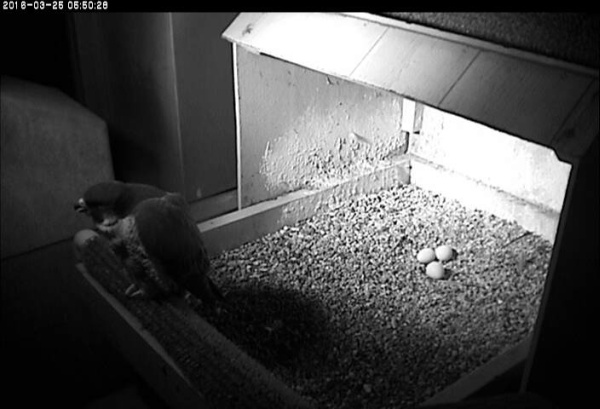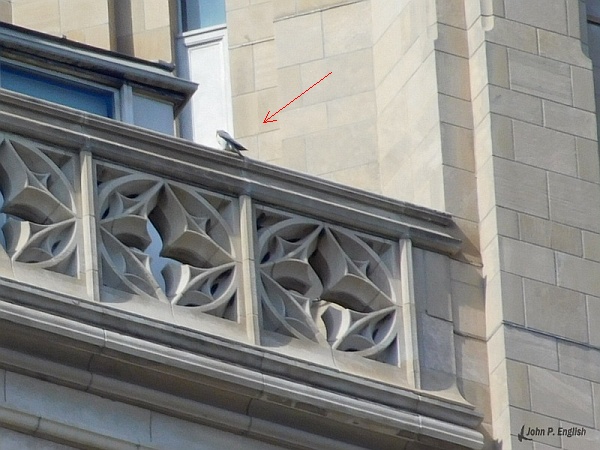
What an exciting day we had yesterday, the first full day of a new male peregrine at Pitt!
Many of you watched the falconcam but all the action was in the air. Of course! Peregrines are famous for top speed flight so naturally they show off their talents in courtship.
Six (and more) of us watched from vantage points in Oakland throughout the day and kept each other up to date on the latest activity. The male’s flight displays were breath taking.
A male peregrine’s first priority is to claim and secure the territory. The new guy made all the right moves: kiting above the Cathedral of Learning, racing across and around the “cliff” face, ostentatiously stooping on prey, and attacking other predators. The local red-tailed hawks took the brunt of his ire. They may have to reconsider their nest location in a tree next to the Cathedral!
Hope and her new mate were conspicuous when they perched. They even mated on the lightning rod, something I hadn’t seen since the days when Dorothy was a younger bird and E2 was new to the site. It’s the ultimate signal that “This cliff is ours!”
The male rarely perched but when he landed above the nest, Hope bowed and ee-chupped. Here’s where he is when she does that:

And … when you hear Hope shouting before dawn (above) she’s making a sound like the begging call. Peregrine males must provide food for their mates during egg-laying, incubation and brooding. The first food delivery is usually at dawn. By calling like this Hope is reminding him of his obligations. She is one loud bird!
Read more here about the details of peregrine courtship in this article: All The Right Moves.
Your Questions: I love to answer your questions but I cannot respond to redundant ones. Questions about Hope’s eggs are answered at this blog post and in the comments which follow it. Please click the link and read the entries before posting a redundant question.
Hope’s loose feather: The feather is not a problem. It will fall out eventually. In the meantime we’ve found it useful for telling the difference between Hope and the male in flight. (Hays bald eagle observers can tell you they use a similar feather trait to identify the eagles at Hays.)
(top photo from the National Aviary snapshot camera at Univ of Pittsburgh. photo of male by John English)
UPDATE: The male came to the nest this morning, March 25, and we captured photos of his bands: Black/Red N/29. Art McMorris, PA Game Commission Peregrine Coordinator, is researching the bird’s origin. He says it will take some time (maybe days) because the band is not in the databases. Art is making phone calls. Please be patient! (Remember, this is Easter weekend so the person who knows the answer may be on vacation.)
Thank you, Kate for the update, and thanks to John for the great photo! It truly is exciting to see and hear the courtship progressing so well.
Thanks for the update. Cant wait to hear if the new male is banded and where he is from!
Good morning-9AM 3/25/2016-just saw the tiercel at the nestbox. Silver USFWS band on the right leg, Black/red band on the left. Could not read the number. Woohoo!
Looks like the male just visited the scrape and was on the nest cam briefly at 8:58 or so. He had a silver band on his right leg. Hopefully you got a good look and read the band? We are anxiously awaiting word from you on his identity, thanks for everything!
Is it possible that Hope’s secret admirer was just on camera, right around 9am? The falcon in the nest didn’t have that loose feather Hope’s been sporting (though maybe it’s just fallen out), seemed to have a bigger light/dark contrast between their back and their tail, and … I think? had silver bands on their right leg (aren’t Hope’s pale green?) … Whoever it was also did a little “dig out”-looking motion towards the front of the nest that I haven’t seen Hope do since her eggs were laid …
Video of the tiercel at the scrape. As he’s leaving the box you can see his R/B VID band
https://youtu.be/huomAOQHL90
Hi got picture of mate at nest
EVERYONE, Art McMorris (PGC) has the band numbers and is researching the male’s origin. Please be patient!
If the new male has a black over red band on the left leg, does that really mean that he is at least 12 years old? The link below says that black over red was used from 1989-2004 with black over green being used from 2000-present.
http://www.ccbbirds.org/what-we-do/research/species-of-concern/peregrine-falcon/report-sightings/
Marissa, that statement applies to ccbbirds.org. Other states are still using black/red
Thanks, Kate!
The engineer in me is squirming at the inconsistency.
I thought it unlikely that an older male would defend the territory so fiercely.
Thanks to all the watchers for posting about the male’s visit to the scrape. And we’re going to find out who he is and where he comes from. This is such exciting news!
One day I’ll get back to Pittsburgh to watch the aerial display of these magnificent birds. Until then, I live vicariously through your eyes. Thanks everyone!
After watching video of the new male moving around the scrape, I’d like to know if this is his attempt to “mark” the nest as his own. Obviously, any other male will know he’s been there. Or is this his way of letting Hope know he intends to stay.
Bethany, the male does not “mark” the nest the way a dog does. Male peregrines move like that when they’re in courtship mode.
I have followed the saga of the peregrines for about four years. I am so happy that Hope has found Dorothy’s vacated nest and will carry on the peregrine legacy. I was so sorry to hear that E2 met an unfortunate fate, but this morning, it sure sounds like love with the arrival of Hope’s new suitor. I can’t wait to see a successful hatching this year. Thank you so much for all the information you provide. My husband and I both enjoy your blogs, both regarding birds and botany topics.
I got a fairly good look at the bands when the new male was in the nest from about 10:12am to 10:15am. Looks like the bands are N/29 with a silver band on the right leg.
There was an Ohio male banded in 2013 that is one number off this one so maybe an Ohio bird 🙂 I know Dorothy and E2 had an offspring or two nesting over there, maybe a descendant?!
I’ve been wondering about something, if you don’t mind another question, Kate? When E2 needed a lady, he advertised and a lady came; now that Hope needs a male, she advertised and a male has shown up. Are there (or can we as humans tell if there are) differences in the way male and female falcons do their courtship/advertising flights, such that only the desired sex responds? Or will falcons of both sexes come by to see what’s up? If the latter, does that mean a falcon advertising they’re alone is taking a risk – e.g., could another female have seen Hope’s advertisement and taken it as a sign that she’d only have to fight off one falcon to “take over” the Cathedral?
Stacyj, the answer is probably ” all of the above.”
If the band numbers are correct, it looks like this could be Sylvester from Chicago, IL according to the Midwest Peregrine Society’s database. Banded in 2011. http://midwestperegrine.umn.edu/
Zack, 29/N means “Black 29 over red N” This bird is Black N over red 29 = N/29
Can’t wait to find out the mystery man’s identity! It gets more and more exciting every day! Thank you for all the updates Kate.
I swear, from Dorothy, to Hope, to E2, to the new suitor, this season with the falcons is going to be the death of me. I’ve been referring to it as “Falcon Crest.” 🙂
THANK YOU KATE!!! You have provided such valuable information. We all truely appreciate all the time snd effort you put into answering our questions.
Wow I just tuned in. Such exiting news and it keeps getting better. Thanks Kate !!
What will happen to the eggs already laid? Will the new guy throw them out? Will he help to hatch these?
birdsinger, here’s usually what happens: The newly formed couple courts and mates and gets in tune with each other. In about two weeks+ the female lays more eggs. Then all the eggs are incubated and some or all hatch. The new male helps raise the family. He does not harm the existing eggs.
This is more exciting than some silly serial people watch on tv!
Will Hope begin to incubate the existing eggs now that the new mate is in the picture?
Now, *this* is a reality show.
Reality worth watching !! I think I saw the male in the nest a little while ago.
Thank you for the update. This is a season of so many emotions.
Is that the male sitting on the eggs
Sheila, no it’s Hope. It looks like her to me and…the females incubate at night.
Thanks Kate. I’m new to all this and very intrigued. Thanks for responding and for all of your informative updates.
Wonderful news!
This is so exciting Kate! Thanks for sharing and can’t wait to see what goes on in the following days/weeks of the new saga of the new generation of Pitt Cathedral of Learning Peregrines. Evolution at its best! 🙂
Hi, could you explain what exactly is the distinction between incubating as opposed to just sitting on/protecting the eggs? Or maybe steer me towards more info about that?
Valerie, For information on incubation, click here. The entire piece is good. Scroll down to the section beginning with “So, just how does incubation work?” for details about the physical part of it. Thanks to Rochester Falconcam for this info.